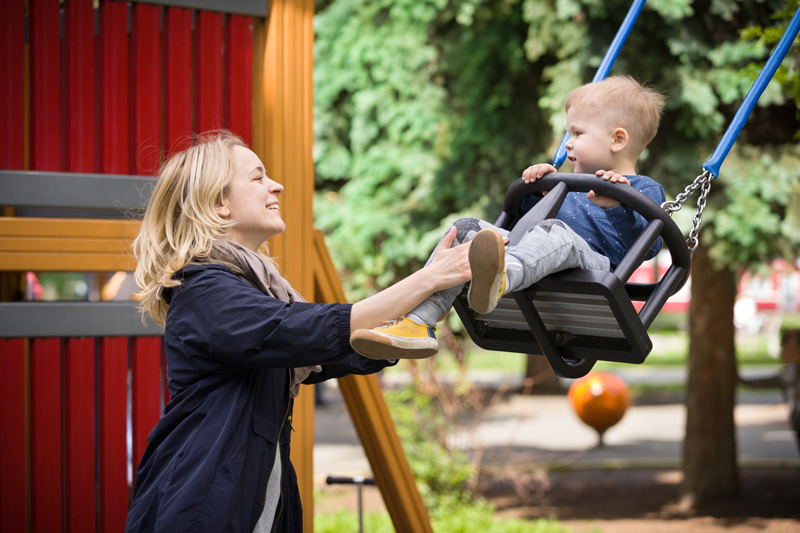Communication is complex and extends beyond verbal expression. This is especially important to understand in non-speaking individuals. Non-verbal cues such as facial expression, body language, and sensory experiences play crucial roles in conveying and understanding messages. Sensory integration strategies are valuable tools to optimize communication by addressing individuals’ sensory needs. The role of sensory processing in shaping our ability to communicate is gaining recognition, with sensory integration strategies emerging as key facilitators. This article explores the profound impact of sensory integration on communication and delves into evidence-based strategies that can be employed to enhance this vital aspect of human interaction.

Understanding Sensory Integration
Sensory integration is a neurological process in the central nervous system that involves receiving sensory information and turning it into functional responses. Successful sensory integration allows a person to feel safe in their environment and maintain an optimal level of arousal and attention by effectively processing and organizing sensory information from the environment. This process is integral to cognitive, emotional, and social functioning, impacting an individual’s overall well-being. For individuals with sensory processing challenges, such as those with autism spectrum disorder (ASD), attention deficit hyperactivity disorder (ADHD), or sensory processing disorder (SPD), difficulties in sensory regulation can significantly impact communication.
The Connection Between Sensory Integration and Communication
Emotional Regulation and Social Interaction:
- Individuals with sensory processing difficulties may experience heightened stress, hindering their communication ability (Pfeiffer et al., 2018).
- Effective sensory modulation fosters emotional regulation, creating a conducive environment for nuanced and meaningful communication (Bunse et al., 2019).
- Proper sensory regulation supports emotional regulation, which is crucial for successful social interactions (Engel-Yeger et al., 2016).
Impact on Attention and Focus:
- Sensory regulation influences attention and focus, essential to effective communication (Miller, 2006). When dysregulated, individuals cannot attend to and focus on communication activities.
- Individuals with sensory challenges may struggle to filter out background sensory stimuli, affecting their ability to concentrate on communication partners and activities (Baranek, 2002).
Evidence-Based Sensory Integration and Regulation Strategies
There are many evidence-based sensory regulation strategies that speech-language pathologists, teachers, and caregivers can employ to facilitate an environment in which an individual can engage in effective communication. Before interweaving communication with sensory-enriched opportunities, it is paramount to remember to ensure safety, present sensory integration and regulation opportunities, tailor activities to present a ‘just right’ challenge, and support a child’s intrinsic motivation to play (O’Brien & Kuhaneck, 2020).
Body Awareness
Body awareness or proprioceptive activities, such as heavy work (i.e., an activity that pushes or pulls against the body) and resistance exercises, provide information from the muscles and joints. This essential sensory integration supports self-regulation and attention (Ayres, 1972; Bundy et al., 2019).
Activity idea: A two-obstacle course with a rewarding item at the end can motivate and build listening and focus skills. These can include picking up medicine balls, rolling on a scooter, or doing wall pushups. You can have pictures of each activity and have the individual choose what they want to do and in what order.
Sight
Our visual system interprets what we see. Visual supports, including visual schedules and pictures, have been shown to enhance communication for individuals with autism spectrum disorders (ASD) and other sensory processing difficulties (Mesibov et al., 2005). Vision is also important in reading body language and other non-verbal cues during social interactions.
Activity idea: Create a communication board to accompany an activity to provide the language scaffold needed to participate. For example, create a Play-Doh Communication Board that includes actions (push, stretch, roll), colors, and requests to facilitate turn-taking and commenting.
Rhythm
Music therapy, including incorporating rhythmic and melodic elements, has demonstrated positive effects on sensory integration and regulation and communication outcomes (Wigram et al., 2002).
Activity idea: Use a metronome or metronome app to create a regulating rhythm and then sing a favorite song incorporating gestures or symbol-based communication (For example, have pictures of the animals from “Old McDonald has a Farm” that the individual can choose).
Touch
Tactile or touch strategies can have a grounding effect and help the individual understand their body positioning or body in space (Schaaf et al, 2018). Tactile preferences can vary widely among individuals. Individualized approaches considering each person’s sensory profile and preferences are important when implementing tactile interventions (Watling & Hauer, 2015).
Activity idea: Touch or tactile cues are sometimes used in articulation therapy. Using simple tactile cues, such as a light touch on the top of the throat to produce the /k/ sound (as in “kick”), can provide a cue that is regulating and helps develop a motor plan. (Note: PROMPT therapy is a method of articulation intervention focusing solely on touch cues.)
Movement and Balance
The vestibular system, located in the inner ear, provides information about the position and movement of the head concerning gravity. Physical activities like swinging or bouncing can help individuals regulate their sensory systems, positively influencing communication (Case-Smith et al., 2015).
Activity idea: While an individual is swinging, say “1-2-3,” and then assist or model the word “go.” Individuals can be encouraged to ask for more when the swing is stopped.
Environmental Modifications
Creating sensory-friendly environments by adjusting light, noise levels, and textures can contribute to improved communication outcomes (Reynolds et al., 2017). This article from Living Autism provides insight into creating an autism-friendly environment that recognizes individual differences.
Mindfulness and Sensory Awareness
Mindfulness practices that heighten sensory awareness contribute to improved self-regulation and communication skills (Keng et al., 2011). Mindfulness is not “one size fits all” and should be viewed through a lens of neurodiversity regarding individuals with autism. Be aware that certain traditional practices may not be regulating. For example, using a bell or chime to indicate the start or ending of a meditation may be dysregulating to an individual with sound sensitivity.
While this article does not cover communication and sensory integration strategies for the gustatory and olfactory systems (taste and smell), it’s essential to acknowledge the significance of these systems in achieving proper sensory regulation. This regulation, in turn, supports emotional regulation and safety, a crucial factor for successful social interactions. Additionally, taste and smell play an important role in therapy for feeding and swallowing issues.
Collaborative Approach for Sensory Integration in Healthcare
The value of interprofessional collaboration in therapy planning and goal development cannot be underestimated when providing support to complex communicators with sensory integration needs. Allied health professionals such as speech-language pathologists and occupational therapists frequently collaborate when problem-solving complex clinical issues. They are a logical team to address the intersection of communication and sensory integration.
Conclusion
Sensory integration is a fundamental component of effective communication, impacting attention, emotional regulation, and social interactions. By understanding the connection between sensory processing and communication, individuals, caregivers, and professionals can implement evidence-based strategies to create supportive environments that foster improved communication outcomes. As research in this field continues to evolve, incorporating sensory integration into communication interventions holds promise for enhancing the quality of life for individuals with diverse sensory needs.
Corrina Riggs, MA, SLP-CCC, is the Director of Related Services at The Guild for Human Services. She can be reached at criggs@guildhumanservices.org.
References
Ayres, A. J. (1973). Sensory integration and learning disorders. In Western Psychological Services eBooks. https://ci.nii.ac.jp/ncid/BA06624771
Ayres, A. J., Robbins, J. A., & Mcatee, S. (2005). Sensory integration and the child : understanding hidden sensory challenges. https://ci.nii.ac.jp/ncid/BB03520256
Baranek, G.T. (2002). Efficacy of sensory and motor interventions for children with autism. Journal of Autism and Developmental Disorders, 32 (5), 397-422.
Bunse, T., Cleary, M., Ee, W.Y., Lane, S.J., & Carpenter, J. (2019). Sensory modulation and affective symptoms in children with autism spectrum disorder. Occupational Therapy International, 2019.
Case-Smith, J., Weaver, L., & Fristad, M. A. (2014). A systematic review of sensory processing interventions for children with autism spectrum disorders. Autism, 19(2), 133–148. https://doi.org/10.1177/1362361313517762
Engel‐Yeger, B., Gonda, X., Muzio, C., Rinosi, G., Pompili, M., Amore, M., & Serafini, G. (2016). Sensory processing patterns, coping strategies, and quality of life among patients with unipolar and bipolar disorders. Revista Brasileira De Psiquiatria, 38(3), 207–215. https://doi.org/10.1590/1516-4446-2015-1785
Keng, S., Smoski, M. J., & Robins, C. J. (2011). Effects of mindfulness on psychological health: A review of empirical studies. Clinical Psychology Review, 31(6), 1041–1056. https://doi.org/10.1016/j.cpr.2011.04.006
Miller, L.J. (2006). An ecological model of sensory modulation: Performance of children with fragile X syndrome, autistic disorder, attention-deficit/hyperactivity disorder, and sensory modulation dysfunction. In D.D. Duane (Ed.), Sensory processing in the nervous system (pp. 57-88). Elsevier Academic Press.
Mesibov, G. B., Shea, V., & Schopler, E. (2004). The TEACCH approach to autism Spectrum Disorders. In Springer eBooks. https://doi.org/10.1007/978-0-306-48647-0
O’Brien, J. C. & Kuhaneck, H. (Eds.). (2020). Case-Smith’s occupational therapy for children and adolescents (8th ed.). Elsevier.
Pfeiffer, B., Kinnealey, M., Reed, C. N., & Herzberg, G. (2005). Sensory modulation and affective disorders in children and adolescents with Asperger’s disorder. American Journal of Occupational Therapy, 59(3), 335–345. https://doi.org/10.5014/ajot.59.3.335
Reynolds, S., Lane, S. J., & Richards, L. (2017). Using sensory features to improve classroom design. Teaching Exceptional Children, 49(4), 245-253.
Schaaf, R. C., Benevides, T., Mailloux, Z., Faller, P., Hunt, J., Van Hooydonk, E., Freeman, R. A., Leiby, B. E., Sendecki, J., & Kelly, D. (2013). An Intervention for Sensory Difficulties in Children with Autism: A Randomized Trial. Journal of Autism and Developmental Disorders. https://doi.org/10.1007/s10803-013-1983-8
Wigram, T. (2002). A comprehensive guide to music therapy : theory, clinical practice, research, and training. In Jessica Kingsley Publishers eBooks. http://ci.nii.ac.jp/ncid/BA6235072X
Watling, R., & Hauer, S. (2015). Effectiveness of Ayres Sensory Integration® and Sensory-Based Interventions for People with Autism Spectrum Disorder: a Systematic review. American Journal of Occupational Therapy, 69(5), 6905180030p1-6905180030p12. https://doi.org/10.5014/ajot.2015.018051





[…] The Power of Sensory Integration: Enhancing Communication for Non-Speaking Individuals – Autis… […]
[…] the diverse needs of individuals with mental health conditions, including sensory processing issues. Take steps to […]
[…] regulation starts with sensory regulation. When children’s bodies and brains receive the right kind of sensory input, they can stay calmer, […]